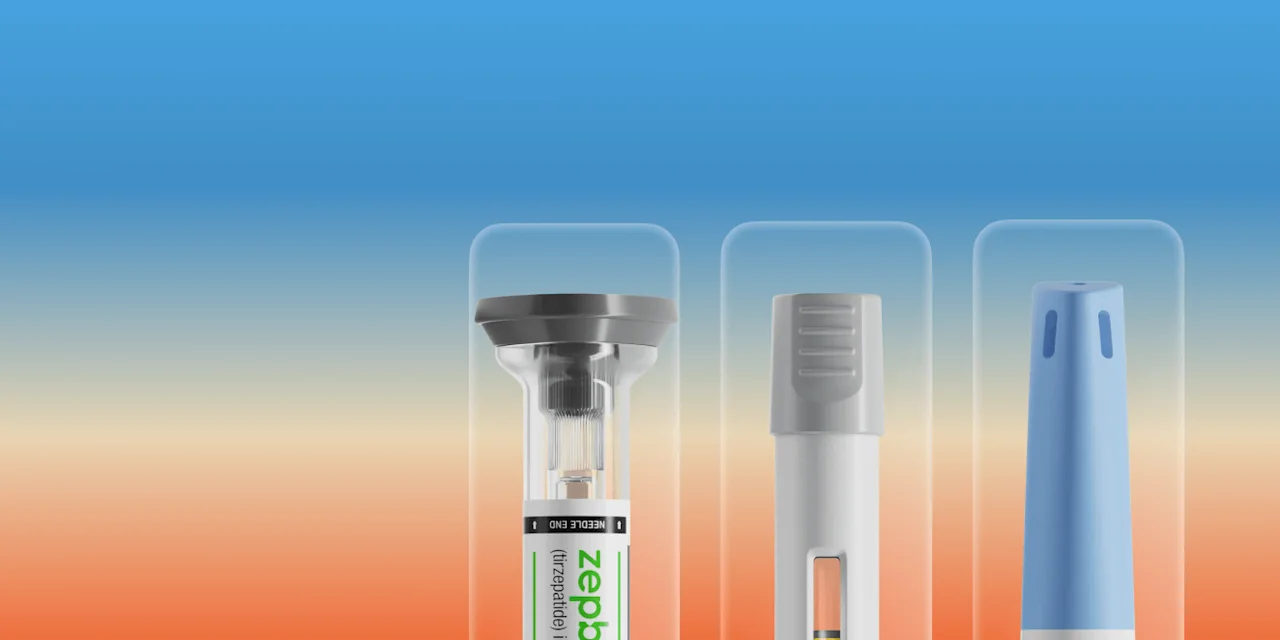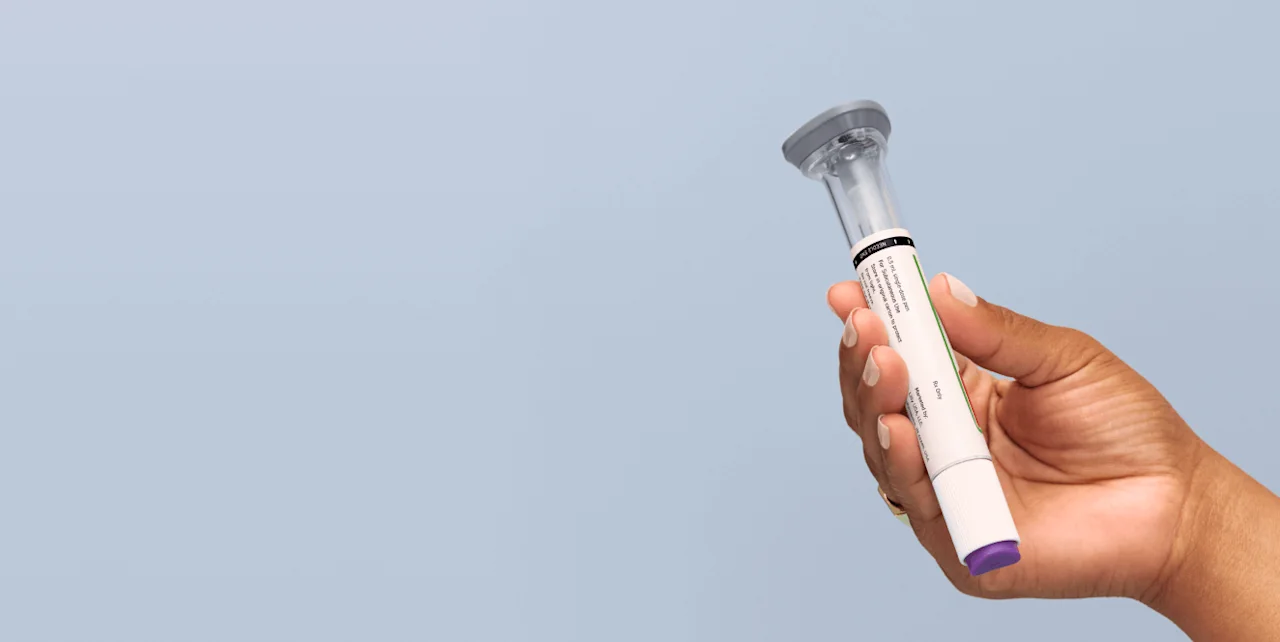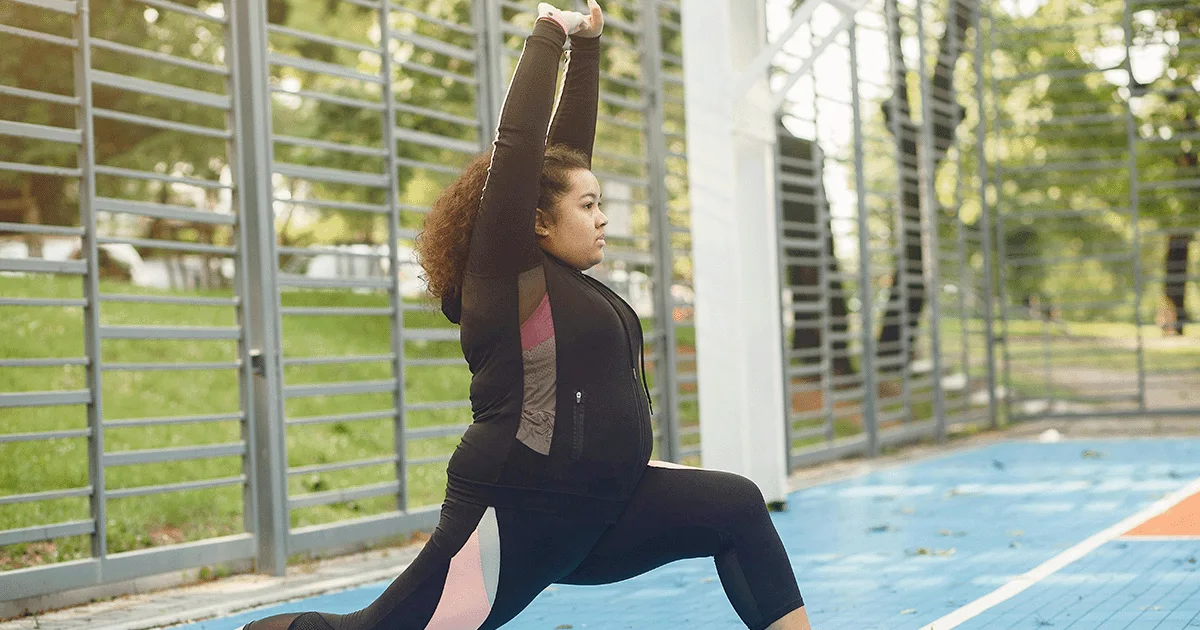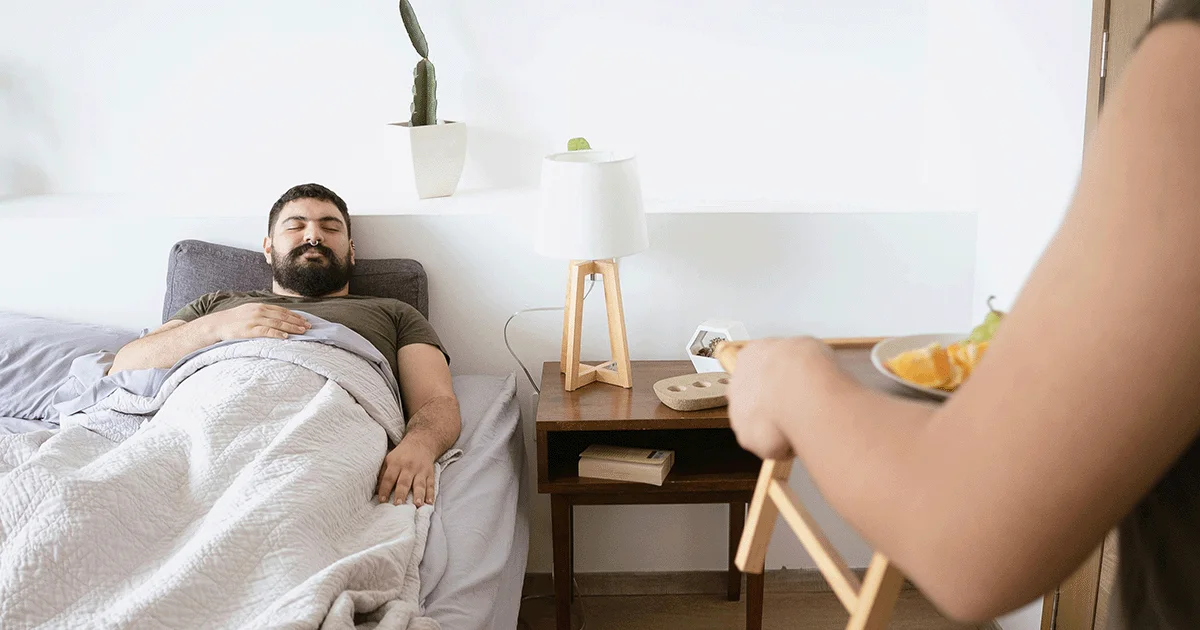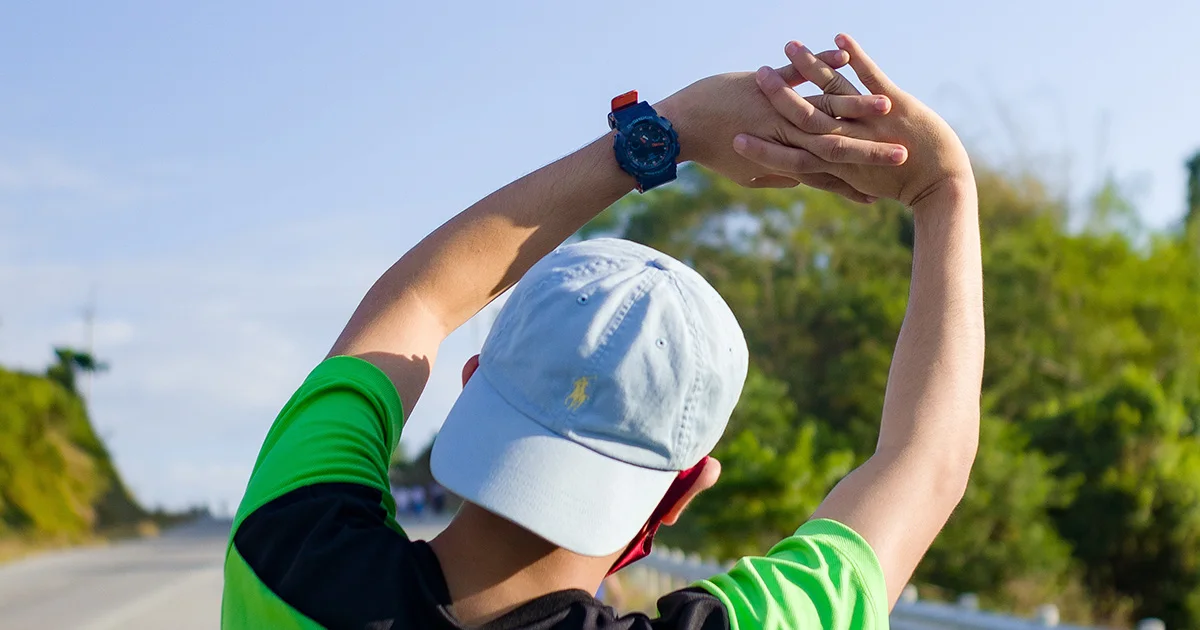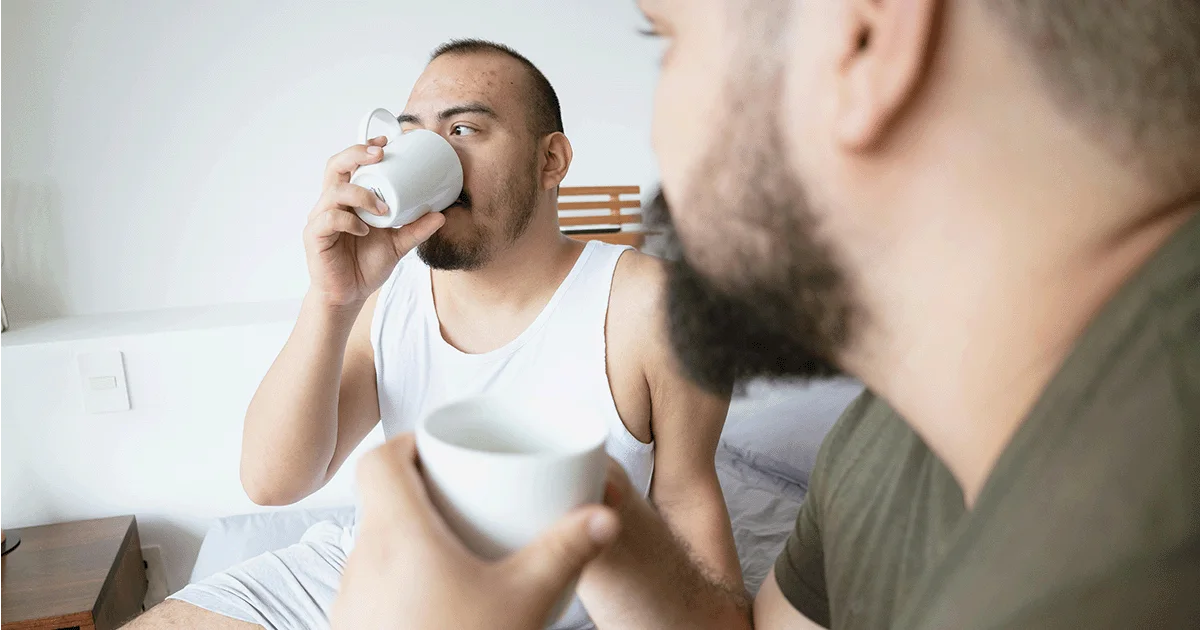Key takeaways
There’s no official tirzepatide diet plan, but eating balanced, nutrient-dense meals helps maximize results, reduce side effects, and support sustainable weight loss.
Focus on a balanced diet full of lean protein, fiber-rich fruits and vegetables, whole grains, and healthy fats to stay full, maintain muscle, and stabilize blood sugar.
Limit fried foods, added sugars, alcohol, and heavily processed meals, which can worsen nausea, slow digestion, and stall progress.
Stay hydrated and active to support digestion, energy, and long-term weight maintenance while on tirzepatide.
Here's what we'll cover
Key takeaways
There’s no official tirzepatide diet plan, but eating balanced, nutrient-dense meals helps maximize results, reduce side effects, and support sustainable weight loss.
Focus on a balanced diet full of lean protein, fiber-rich fruits and vegetables, whole grains, and healthy fats to stay full, maintain muscle, and stabilize blood sugar.
Limit fried foods, added sugars, alcohol, and heavily processed meals, which can worsen nausea, slow digestion, and stall progress.
Stay hydrated and active to support digestion, energy, and long-term weight maintenance while on tirzepatide.
The GLP-1 medication tirzepatide works best when combined with a balanced diet and regular exercise; however, what does that actually look like in practice? While there’s no official tirzepatide diet plan, certain foods can help you feel your best, support weight loss, and minimize side effects. As your appetite and eating habits change while taking the medication, making thoughtful food choices can help you stay energized, promote healthy digestion, and maximize the benefits of your treatment.
Foods to eat on tirzepatide
When taking tirzepatide (prescribed as Mounjaro for type 2 diabetes and Zepbound for weight loss), focusing on nutrient-dense foods that promote fullness and stabilize blood sugar can help you get the most out of the treatment, says Lauren Harris-Pincus, MS, RDN, Ro Dietitian Advisor and cookbook author. Many people find that their appetite decreases, which makes the quality of each meal even more important.
Fruits and vegetables
Examples of what to eat:
Apples
Pears
Berries
Leafy greens (e.g. spinach, kale)
Broccoli
Carrots
How much to eat: Using the plate method as a guide, aim to fill half your plate with fruits and non-starchy vegetables (mostly vegetables!) in different colors and textures to help meet your fiber needs.
Fruits and veggies are rich in fiber, which promotes gut health, supports regularity, and helps prevent constipation — a common side effect of tirzepatide, according to Daria Zajac, RD, LDN, diabetes dietitian at Nourished By Daria. Fiber also helps stabilize blood sugar levels and increase feelings of fullness, which can aid in weight management.
Whole grains and legumes
What to eat:
Brown rice
Quinoa
Farro
Barley
Chickpeas
Lentils (FYI: lentils can be a source of both healthy carbohydrates and protein
How much to eat: Fill about one-quarter of your plate with whole grains or legumes.
These slow-digesting carbohydrates are high in fiber and key nutrients like magnesium and zinc, which support metabolism and blood sugar control, says Zajac. Choosing high-fiber carbs also helps maintain energy and prevent digestive discomfort as your overall intake decreases.
Lean protein
What to eat:
Skinless poultry (e.g. chicken, turkey)
Fish (e.g. salmon)
Eggs (but limit yolks!)
Tofu
Tempeh
Legumes (e.g. edamame, lentils) can be a source of both healthy carbohydrates and protein
Low-fat dairy (e.g. Greek yogurt)
How much to eat: Aim for 1.2-1.6 grams of protein per kg of body weight per day, or roughly one-quarter of your plate at meals. At the very least, try to get 0.8 grams of protein per kg to meet your basic needs and maintain muscle.
“Without adequate protein, a higher percentage of weight loss can come from muscle, and we want to avoid it whenever possible,” Harris-Pincus says. That’s why eating plenty of lean protein helps preserve muscle and metabolism during weight loss.
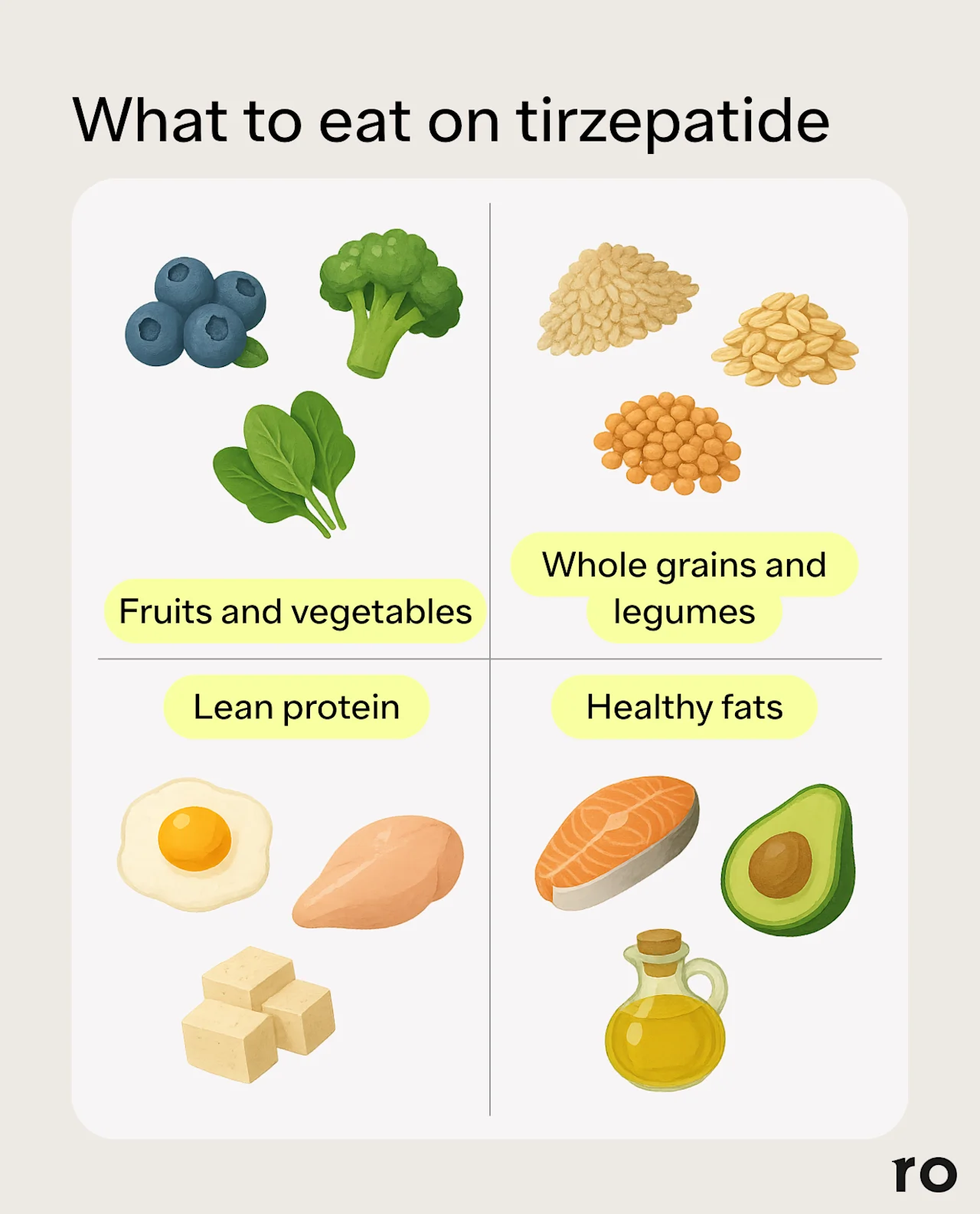
Healthy fats
What to eat:
Nuts (e.g. walnuts)
Seeds (e.g. flax seeds, sunflower seeds)
Fatty fish (e.g. salmon, tuna)
Vegetable oils (e.g. canola oil, olive oil)
How much to eat: Healthy fats should make up 20%-35% of your daily calorie intake. Typically, this means including small portions in each meal (for example, a drizzle of oil or a small handful of nuts).
Healthy fats provide long-lasting satiety, aid nutrient absorption, and support heart health. Studies show that diets rich in monounsaturated fats (rather than saturated or fried foods) are linked to better body composition and blood sugar control.
Water
What to drink:
Water
Non-caffeinated (and ideally unsweetened) tea
Foods with high water content, like fruits and vegetables
Staying well-hydrated is especially important when increasing fiber intake, since fiber absorbs water to keep digestion moving smoothly. Together, water and fiber help prevent constipation — a common side effect of GLP-1 medications — and support overall comfort and regularity as your appetite adjusts.
Foods to avoid on tirzepatide
While certain foods can help you feel your best on tirzepatide, others may trigger side effects or slow your progress. Limit items high in added sugar, saturated fat, or sodium, which can increase gastrointestinal discomfort and make weight loss harder to sustain, Harris-Pincus says.
Saturated and fried foods
What to limit or avoid:
Fried chicken
Bacon and sausage
Fries
Butter
High-fat cuts of meat
According to Harris-Pincus, fried and fatty foods are high in calories and slow digestion, which can worsen reflux, nausea, and bloating — common side effects of tirzepatide. They’re also calorie-dense, making it harder to maintain a calorie deficit for weight loss, Zajac says.
Foods with added sugars and refined carbohydrates
What to limit or avoid:
Pastries and baked goods
White bread and pasta
Sugary cereals
Soda and energy drinks
Sweetened coffee drinks
Desserts and candy
These foods can spike blood sugar and cause energy crashes. “Sugar-sweetened foods and beverages can hinder weight loss while taking up valuable space in the diet for people with a limited appetite,” Harris-Pincus says. They can also worsen blood sugar control in people with type 2 diabetes.
Alcohol
What to limit or avoid:
Beer
Wine
Mixed drinks
Cocktails made with sugary mixers
Alcohol adds empty calories and can lower blood sugar unpredictably when mixed with tirzepatide, according to Harris-Pincus. For many people, cutting back — or pausing alcohol altogether — can improve energy and weight-loss outcomes.
Highly processed and salty foods
What to limit or avoid:
Most packaged snacks and chips
Fast food
Frozen meals
Processed deli meats
Takeout dishes high in sodium
These foods are often low in fiber and protein and high in hidden sugars and unhealthy fats, making it harder to feel satisfied and maintain steady energy levels. Excess sodium can also raise blood pressure and contribute to bloating or water retention.
Potential reflux triggers
What to avoid:
Spicy foods
Citrus fruits
Tomatoes
Chocolate
Carbonated drinks
These items may aggravate acid reflux — a common side effect of tirzepatide, Harris-Pincus says. Coffee, in particular, can be both a trigger for reflux and a hidden source of calories when prepared with cream or syrup.
Sample tirzepatide diet plan
Structuring your meals around protein, fiber, and hydration can help you feel full, support digestion, and maintain muscle as you lose weight. Here’s a sample one-day plan to use as a starting point.
Breakfast
What to eat:
Greek yogurt topped with berries and chia seeds
1 slice of whole-grain toast with avocado
Glass of water or unsweetened green tea
Why it works: The combination of protein, healthy fat, and fiber promotes satiety and stabilizes blood sugar, helping prevent nausea and energy dips later in the day.
Mid-morning snack
What to eat: Apple slices with 1–2 tablespoons of nut butter
Why it works: A fiber-rich fruit paired with protein keeps hunger steady between meals and supports digestion.
Lunch
What to eat:
Grilled chicken or tofu
Mixed greens with quinoa, chickpeas, and olive oil vinaigrette
Sparkling water with lemon
Why it works: This complete plate delivers lean protein and fiber to maintain muscle and fullness while providing slow-digesting carbs for sustained energy.
Afternoon snack
What to eat: Hummus with carrot sticks, bell pepper, or cucumber slices
Why it works: This combo adds plant-based protein and fiber to keep you satiated until your next meal.
Dinner
What to eat:
Baked salmon or lentil stew
Steamed broccoli and roasted sweet potato
Glass of water or herbal tea
Why it works: Balanced portions of protein, complex carbs, and veggies support muscle recovery and digestive health while keeping calories moderate.
Evening (if hungry)
What to eat: Low-fat cottage cheese or protein shake
Why it works: A light, protein-focused option before bed can help you hit your daily protein goals and support overnight muscle repair and growth (when paired with regular exercise).
Weight loss tips while on tirzepatide
Tirzepatide can make it easier to eat less by reducing appetite, but long-term success depends on more than the medication alone. These strategies can help you maximize results and feel your best throughout treatment and even afterwards, if you and your healthcare provider ever decide to discontinue the medication.
1. Stay consistent with movement
Exercise enhances fat loss and helps maintain muscle. Resistance training, in particular, has been shown to support muscle growth and metabolic health while on calorie-restricted diets.
2. Plan balanced, smaller meals
As your appetite decreases, it may feel uncomfortable to eat large portions. Instead, try smaller, nutrient-dense meals spaced evenly throughout the day to ensure you’re getting enough protein, fiber, and hydration, Harris-Pincus says.
3. Get enough sleep
Research shows that poor sleep can affect appetite hormones and slow weight loss, so aim to get seven to nine hours of quality sleep every night to support recovery and metabolism.
4. Track your progress and side effects
Note how your body responds to tirzepatide, such as changes in appetite, digestion, and energy, says Zajac. This can help you identify triggers for side effects and share valuable information with your healthcare provider for any needed adjustments.
Bottom line
Tirzepatide helps reduce hunger, which can make it easier to eat less and lose weight. But food quality still plays a major role in how you feel and how well the medication works. Choosing nourishing, balanced meals can help you stay full, avoid side effects, and support long-term success. Here’s what to keep in mind:
Prioritizing lean protein, fiber-rich fruits and vegetables, whole grains, and healthy fats can help you feel fuller for longer, support your overall nutrition, and reduce common side effects like constipation that can come with tirzepatide.
Limiting processed snacks, fried foods, sugary drinks, and alcohol not only supports your weight-loss goals but can also help you feel more energized and satiated while on the medication.
The plate method — a simple visual tool for portioning out meals — offers a practical way to balance nutrients and guide your food choices, all while leaving room for flexibility and personal preferences.
Ultimately, the best tirzepatide diet is one that nourishes your body, fits comfortably into your daily routine, and supports your health goals in a way that feels sustainable over the long term.
Frequently asked questions (FAQs)
Is there a recommended tirzepatide diet plan?
There’s no one-size-fits-all tirzepatide diet plan, but in general, it works best when paired with a balanced, reduced-calorie diet and regular physical activity. Focus on meals built around lean protein, fiber-rich carbs, and plenty of fruits and vegetables. The simple “plate method” — half produce, one-quarter lean protein, and one-quarter whole grains — can help guide portions while keeping your diet flexible and nutrient-dense.
What should I eat while taking tirzepatide?
Aim for meals centered around lean proteins and fiber-rich foods, Harris-Pincus says. Fruits, vegetables, whole grains, and legumes are all nutrient-dense options that can help keep you full and energized. Healthy fats (like nuts, seeds, and olive oil) can also provide your body with essential nutrients and help control your blood sugar. Ultimately, balance and food quality matter more than rigid meal timing or calorie counting.
Can you drink coffee on tirzepatide?
Yes — if tolerated. Coffee may trigger reflux or nausea in some, especially soon after your injection, according to Harris-Pincus. “Use caution within the first few days after your injection, avoid consuming it on an empty stomach, and watch how many calories you may be adding in via sugar, syrups, or milk options,” she says.
Can I eat normally on Mounjaro?
“No food is entirely off limits while taking tirzepatide,” Harris-Pincus says. What’s more important is that you prioritize nutrient-dense options like fruits, vegetables, whole grains, and lean proteins over high-calorie, low-nutrient foods like processed snacks. Because tirzepatide lowers appetite, “eating normally” might also mean eating smaller portions than you’re used to.
How many calories should I eat on tirzepatide?
There’s no one-size target, Zajac says, and calorie needs vary by weight, height, age, gender, activity, and goals. However, Harris-Pincus warns against going below 1,200 calories per day because it’s difficult to meet macro- and micronutrient needs at such a low-calorie intake.
Can I eat bananas on tirzepatide?
Yes, you can eat bananas on tirzepatide. Bananas offer fiber, potassium, and natural sweetness, Harris-Pincus says. As an added bonus, they’re portable, require no prep, and make for a convenient on-the-go snack that fits easily into most balanced meal plans. That said, the starch in bananas can cause constipation for some people. Constipation is also a common side effect of tirzepatide, so if you’re experiencing it, consider opting for different fruits instead.
The one caveat: if you take certain blood pressure medications which can raise potassium levels or have certain types of kidney disease, check with your healthcare provider about how often you should consume high-potassium fruits like bananas.
Can I eat bread on tirzepatide?
Yes, you can eat bread while taking tirzepatide, though it’s best to prioritize whole-grain varieties to help boost your fiber intake and support digestion. Whole-grain bread is more filling and nutritious than refined white bread, making it a better option for weight management, Harris-Pincus says. She also suggests eating your protein and produce first, as this ensures you get essential nutrients in before you feel full, which can happen more quickly while on tirzepatide.
DISCLAIMER
If you have any medical questions or concerns, please talk to your healthcare provider. The articles on Health Guide are underpinned by peer-reviewed research and information drawn from medical societies and governmental agencies. However, they are not a substitute for professional medical advice, diagnosis, or treatment.
Zepbound Important Safety Information: Read more about serious warnings and safety info.
Mounjaro Important Safety Information: Read more about serious warnings and safety info.
GLP-1 Important Safety Information: Read more about serious warnings and safety info.
References
Akbar, A. & Shreenath, A. P. (2023). High Fiber Diet. StatPearls. Retrieved from https://www.ncbi.nlm.nih.gov/books/NBK559033/
Alyafei, A., Balfour, J., & Keyes, D. (2023). Physical Activity and Weight Loss Maintenance. StatPearls. Retrieved from https://www.ncbi.nlm.nih.gov/books/NBK572051/
Bae, S. H. (2014). Diets for constipation. Pediatric Gastroenterology, Hepatology & Nutrition, 17(4), 203–208. doi: 10.5223/pghn.2014.17.4.203. Retrieved from https://pmc.ncbi.nlm.nih.gov/articles/PMC4291444/
Bouchaud, C. C., Chriqui, J. R., Slim, M., et al. (2023). A Qualitative Evaluation of a Plate-Method Dietary Self-Monitoring Tool in a Sample of Adults Over 50. Current Developments in Nutrition, 7(8), 101975. doi: 10.1016/j.cdnut.2023.101975. Retrieved from https://pmc.ncbi.nlm.nih.gov/articles/PMC10436173/
Coniglio, S., Shumskaya, M., & Vassiliou, E. (2023). Unsaturated Fatty Acids and Their Immunomodulatory Properties. Biology, 12(2), 279. doi: 10.3390/biology12020279. Retrieved from https://pmc.ncbi.nlm.nih.gov/articles/PMC9953405/
DiNicolantonio, J. J. & O'Keefe, J. H. (2022). Monounsaturated Fat vs Saturated Fat: Effects on Cardio-Metabolic Health and Obesity. I(1), 69–73.. Retrieved from https://pmc.ncbi.nlm.nih.gov/articles/PMC9312452/
LaPelusa, A. & Kaushik, R. (2023). Physiology, Proteins. I Retrieved from https://www.ncbi.nlm.nih.gov/books/NBK555990/
Liu, A. G., Ford, N. A., Hu, F. B., et al. (2017). A healthy approach to dietary fats: understanding the science and taking action to reduce consumer confusion. Nutrition Journal, 16(1), 53. doi: 10.1186/s12937-017-0271-4. Retrieved from https://pmc.ncbi.nlm.nih.gov/articles/PMC5577766/
Lu, L., Chen, C., Yang, K., et al. (2020). Magnesium intake is inversely associated with risk of obesity in a 30-year prospective follow-up study among American young adults. European Journal of Nutrition, 59(8), 3745–3753. doi: 10.1007/s00394-020-02206-3. Retrieved from https://pmc.ncbi.nlm.nih.gov/articles/PMC7483156/
Mantantzis, K., Schlaghecken, F., Sünram-Lea, S. I., & Maylor, E. A. (2019). Sugar rush or sugar crash? A meta-analysis of carbohydrate effects on mood. Neuroscience and Biobehavioral Reviews, 101, 45–67. doi: 10.1016/j.neubiorev.2019.03.016. Retrieved from https://pubmed.ncbi.nlm.nih.gov/30951762/
Mechanick, J. I., Butsch, W. S., Christensen, S. M., et al. (2025). Strategies for minimizing muscle loss during use of incretin-mimetic drugs for treatment of obesity. Obesity Reviews : An Official Journal of the International Association for the Study of Obesity, 26(1), e13841. https://doi.org/10.1111/obr.13841. Retrieved from https://onlinelibrary.wiley.com/doi/10.1111/obr.13841
Moon, J. & Koh, G. (2020). Clinical Evidence and Mechanisms of High-Protein Diet-Induced Weight Loss. Journal of Obesity & Metabolic Syndrome, 29(3), 166–173. doi: 10.7570/jomes20028. Retrieved from https://pmc.ncbi.nlm.nih.gov/articles/PMC7539343/
Mozaffarian, D., Agarwal, M., Aggarwal, M., et al. (2025). Nutritional priorities to support GLP-1 therapy for obesity: A joint Advisory from the American College of Lifestyle Medicine, the American Society for Nutrition, the Obesity Medicine Association, and The Obesity Society. Obesity (Silver Spring, Md.), 10.1002/oby.24336. Advance online publication. doi: 10.1002/oby.24336. Retrieved from https://onlinelibrary.wiley.com/doi/10.1002/oby.24336
Papatriantafyllou, E., Efthymiou, D., Zoumbaneas, E., et al. (2022). Sleep deprivation: Effects on weight loss and weight loss maintenance. Nutrients, 14(8), 1549. doi: 10.3390/nu14081549. Retrieved from https://pmc.ncbi.nlm.nih.gov/articles/PMC9031614/
Pramono, A., Fitranti, D. Y., Nugroho, K. H., et al. (2023). The Association between Unhealthy Food Consumption and Impaired Glucose Metabolism among Adults with Overweight or Obesity: A Cross-Sectional Analysis of the Indonesian Population. Journal of Obesity, 2023, 2885769. doi: 10.1155/2023/2885769. Retrieved from https://pmc.ncbi.nlm.nih.gov/articles/PMC10060072/
Sharma, S. P., Chung, H. J., Kim, H. J., & Hong, S. T. (2016). Paradoxical Effects of Fruit on Obesity. Nutrients, 8(10), 633. doi: 10.3390/nu8100633. Retrieved from https://pmc.ncbi.nlm.nih.gov/articles/PMC5084020/
Smethers, A. D. & Rolls, B. J. (2018). Dietary Management of Obesity: Cornerstones of Healthy Eating Patterns. The Medical Clinics of North America, 102(1), 107–124. doi: 10.1016/j.mcna.2017.08.009. Retrieved from https://pmc.ncbi.nlm.nih.gov/articles/PMC5726407/
Thapsuwan, S., Phulkerd, S., Chamratrithirong, A., et al. (2024). Relationship between consumption of high fat, sugar or sodium (HFSS) food and obesity and non-communicable diseases. BMJ Nutrition, Prevention & Health, 7(1), 78–87. doi: 10.1136/bmjnph-2023-000794. Retrieved from https://pmc.ncbi.nlm.nih.gov/articles/PMC11221281/
U.S. Food & Drug Administration (FDA). (2025). Highlights of Prescribing Information: Mounjaro (tirzepatide) Injection, for subcutaneous use. Retrieved from https://www.accessdata.fda.gov/drugsatfda_docs/label/2025/217806s031lbl.pdf
U.S. Food & Drug Administration (FDA). (2025). Highlights of Prescribing Information: Zepbound (tirzepatide) Injection, for subcutaneous use. Retrieved from https://www.accessdata.fda.gov/drugsatfda_docs/label/2025/217806s031lbl.pdf
U.S. Food and Drug Administration. (2024). Sodium in Your Diet. Retrieved from https://www.fda.gov/food/nutrition-education-resources-materials/sodium-your-diet
U.S. National Library of Medicine. (2024). Constipation — self-care. Retrieved from https://medlineplus.gov/ency/patientinstructions/000120.htm
Wu, W. C., Inui, A., & Chen, C. Y. (2020). Weight loss induced by whole grain-rich diet is through a gut microbiota-independent mechanism. World Journal of Diabetes, 11(2), 26–32. doi: 10.4239/wjd.v11.i2.26. Retrieved from https://pmc.ncbi.nlm.nih.gov/articles/PMC6969707/


